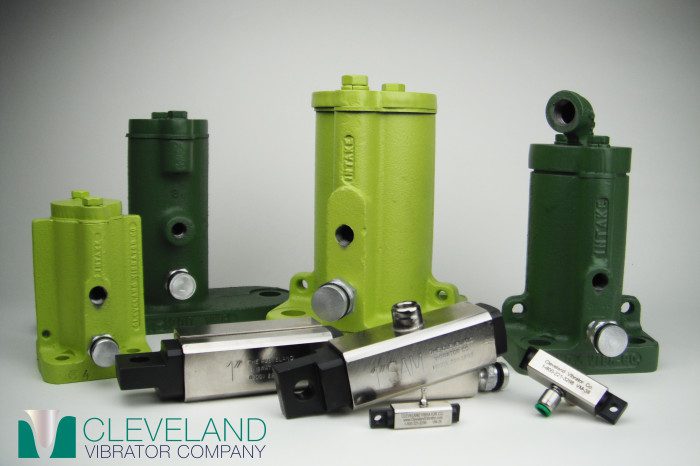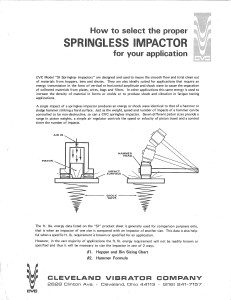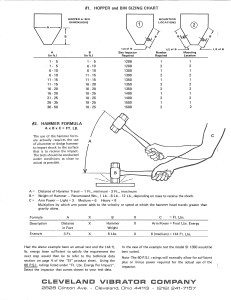Recently the sales team forwarded the following question from a customer –
“We use some of your impulse piston vibrators to fill molds with powder. Do you have a recommendation for a way to measure the strike force such as a G-force meter or Accelerometer? Any ideas you have would be greatly appreciated.”
This seems like a pretty straight forward question but upon closer inspection, it gets a bit more complex. So let’s break it down and look at the pieces of the question. It’s always important to make sure we’re on the same page in our understanding of the question and terminology used.
“Impulse piston vibrators” – By indicating that the vibrator(s) is an “impulse piston” vibrator we can quickly rule out a number of vibrators that might otherwise be used in a compaction application. Cleveland Vibrator is often asked to build vibratory tables to compact a variety of materials in a customer’s mold. On those applications the sales team will typically recommend the use of a vibratory table or packer. Depending on the material load, nature of the material and space available, the company’s normal recommendation is a flat deck FA style table with rotary electric vibrators (RE) selected based on operating frequency and force output. The piston vibrator reference rules out the use of rotary electric vibrators to power the table or customer fabricated device. Over the years we’ve manufactured a good number of compaction tables using piston vibrators; it’s just a matter of matching the material, load and the “right” vibrator. Likewise, we can rule out the use of ball vibrators or turbine vibrators which might be located at multiple points on the mold to assist with settling the product and filling voids in the mold.
So we know it’s a piston vibrator but we’re still wondering what the customer means when they use the word “impulse”. One of the definitions for “impulse” offered by the Merriam-Webster dictionary is “a small amount of energy that moves from one area to another.” While this definition makes sense in terms of piston vibrators, we are imparting energy into the mounted location of the vibrator and then into another area of say a hopper, bin or mold. A “small amount of energy” could be produced by an assortment of piston vibrators ranging from the VM-25, miniature piston vibrator, on up in size to the strong and compact SA-EP line. With an unknown and unspecified mold size it’s hard to say what the customer might be using. Additionally, we don’t know if the vibrator is an air cushioned or impact vibrator.
If Cleveland Vibrator was designing a compact table and the requirement was to use a pneumatic vibrator, 99% of the time we’d use an air cushioned unit. While the same size air cushioned unit will produce less force than the impact unit, we typically opt for the less powerful but quieter air cushioned unit. So perhaps the end user has a 1350 VMSAC unit mounted to an isolated table of their design and are using this to compact material in the mold. If that’s the case I’d recommend one type of instrument over another, but I still don’t know what they’re using.
One option to help me understand the application and maybe reduce the choices of vibrators used would be to look at the customer’s history. I accessed our data base and went into the sales module and searched for the customer and in turn their sales history. Unfortunately, I didn’t find anything in our system using the given company name. Perhaps they purchased the mystery vibrator through one of Cleveland Vibrator’s resale partners. Some of our customers would prefer not to set up an account with us and want to work through one of their existing suppliers. Maybe the customer purchased the vibrator through McMaster-Carr, Grainger, Motion Industries or Kaman difficult to say.
Reading back over the email the phrase “strike force” triggered an image in my head of an old piece of literature that was created for the Single Impact (SI) vibrator line (see literature in below images). The strike related to the image of a hammer hitting a surface, maybe he’s got a SI unit helping to move material in the mold. That’d be an interesting choice for the application. Typically SI units are recommended for use with wet or sticky materials, could it be that their material is a bit moist? Most likely. If that’s the case, the SI is a good match for the product/mold combination.
So we’ve got it down to three general families of vibrators: Impact, Single Impact and Air Cushioned. From my experience, each would need to be instrumented a bit differently.
Starting with the easiest Air Cushioned. There are a variety of hand held vibration monitors out there; we’ve used one for years with good success in measuring acceleration and displacement. Not a real problem.
The impact vibrator, as I’ve said in previous blogs, is a bit more difficult because of the high acceleration seen by the sensor due to the steel on steel impact of the piston striking the mounting channel or mounting head. Using the acceleration to determine the force output of the vibrator isn’t the best route. But if the customer wants a means to monitor the performance of the vibrator as a process parameter, then looking at the acceleration would seem reasonable. If the ideal mold results are achieved with the vibrator generating say, 4-5 G’s, that would be fine. As long as they’re not trying to determine a force output of the vibrator based on the g’s, they should be good. What device to use with the accelerometer is still a problem. The hand held units that I’ve seen and used simply cannot handle the mode of vibration generated by an impact vibrator. As I’ve mentioned before the only thing I’ve found for an impact vibrator is Crystal Instrument’s CoCo-80.
The SI would be the most difficult to instrument. Not only do we have the high energy impact of steel on steel but we also have a slower cycling unit. Capturing the impact of the SI piston as it strikes the plate would take a combination of a shock resistant accelerometer, a high sampling rate and a meter or device that could capture and hold a peak value. With a continuously operating VMS unit, we can sample and average the data, I’m inclined to think that it would be more difficult to do that with something like the SI vibrator that strikes at adjustable intervals instead of continuously. I’ve been thinking about trying to capture data on the SI line, if I do it, I’d be using the CoCo-80, seems reasonable but it would certainly require playing with the instrument parameters.
I think I’ll have to set up a single Impact unit and see what type of data I can collect. It would be interesting to compare the acceleration generated by a 1200 VMS and a 1200 SI. Is there a difference in the instantaneous force produced by the two different pistons, how does the frequency of operation change the dynamics of the vibrator? Something to investigate, so stay tuned for the results.
Share this blog post:
Follow us:





3 Responses to 3 Ways To Measure The Strike Force Of A Pneumatic Vibrator